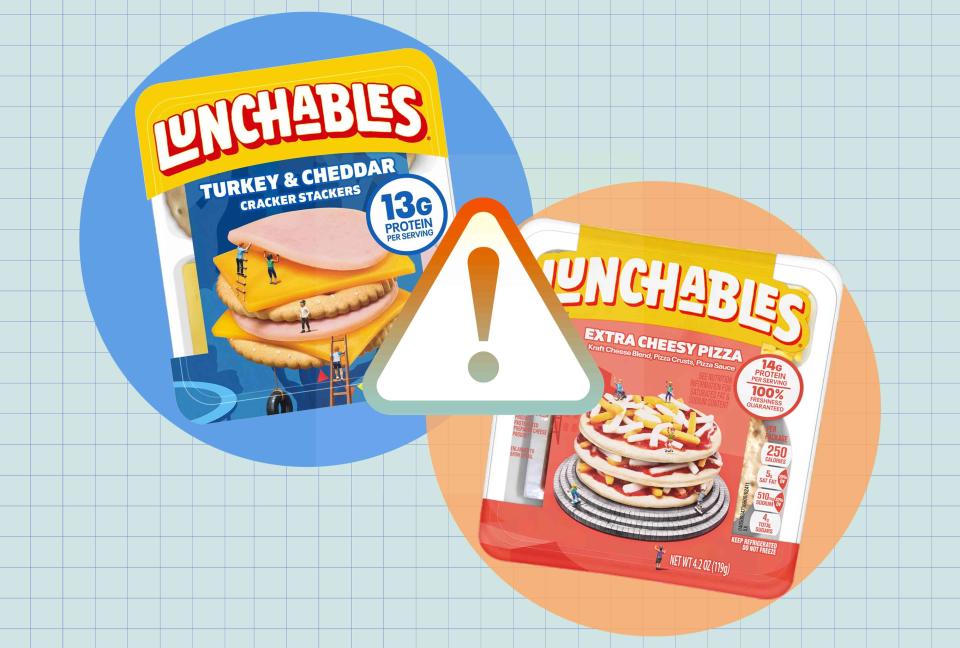Consumer Reports Just Found High Levels of Lead in Lunchables—and Warn About Sodium Content
Here’s what to keep in mind before packing your next lunch.

Courtesy of Brand
Reviewed by Dietitian Emily Lachtrupp, M.S., RD
When you think of Lunchables, the popular lunch snack kits featuring staples like cheese crackers, mini pizzas and more, a few words may come to mind. “Nostalgic,” “easy” and even “tasty” are likely to pop in your head. But now, Consumer Reports wants you to consider two more words: “lead” and “sodium.”
Recent tests conducted by CR found that various Lunchables and other similar packaged lunch products on the market not only have an excessive amount of sodium, but they tested positive for high amounts of lead, some of which even contain high amounts of cadmium, another heavy metal, as well.
“We don’t think anybody should regularly eat these products, and they definitely shouldn’t be considered a healthy school lunch,” says CR chemist and test leader Eric Boring, PhD in the report.
Related: One-Third of Chocolate Products Are High in Heavy Metals—Here's What to Know
Here is the list of the 12 packaged lunch products tested by CR and ranked from highest to lowest lead content, with the percentage after each product noting its amount of the recommended daily limit of lead:
Lunchables Turkey and Cheddar Cracker Stackers: 74%
Lunchables Pizza with Pepperoni: 73%
Lunchables Extra Cheesy Pizza: 69%
Armour LunchMakers Cracker Crunchers Ham & American: 67%
Target’s Good & Gather Uncured Ham and Cheddar Cheese Lunch Kit: 57%
Armour LunchMakers Cracker Crunchers Turkey & American: 44%
Greenfield Natural Meat Co. Smoked Turkey & Cheese Lunch Kit: 37%
Target’s Good & Gather Smoked Turkey and Cheddar Cheese Lunch Kit: 30%
Oscar Mayer Natural Honey Smoked Turkey Breast: 24%
Oscar Mayer Natural Hickory Smoked Uncured Ham: 21%
P3 Turkey Ham Cheddar: 10%
P3 Turkey Colby Jack Almonds: 7%
While none of these products exceed 100%, it puts children at risk of surpassing the advised limit for lead consumption.
“For example, the kits provide only about 15 percent of the 1,600 daily calories that a typical 8-year-old requires, but that small amount of food puts them fairly close to the daily maximum limit for lead,” the report explains. “Even if one meal kit doesn’t push a child over the limit, it puts them in the danger zone because there will likely be exposure from other sources.”
The Lunchables Pizza with Pepperoni and the Lunchables Extra Cheesy Pizza also contain over 50% of the recommended limit for cadmium. Both lead and cadmium are heavy metals that are naturally found in the environment, and we had our social media specialist and registered dietitian Annie Nguyen, M.A., RD explain this further.
"Lead can be in the soil, water or environment where food is grown or processed at," she says. "As a result, fresh produce (like grains, vegetables, and fruit) and other food items can have amounts of lead."
The idea that there's heavy metals in our food may seem frightening, but Nguyen says that we shouldn't worry.
"While it does sound scary that lead could be in food, the FDA does monitor and regulate the amount of lead in food," she states. "If there was an alarming amount of lead in a particular product, the FDA would take regulatory action and take it off the market."
Related: What Are Toxic Heavy Metals—and Should You Be Worried About Them?
Lead isn't the only thing we should worry about when it comes to Lunchables, according to the investigation. All of the CR tested products contained 30% to 49% of the recommended sodium intake. This isn’t too surprising as cold cut meats, pizza and cheese are among the top 10 food sources of sodium for people ages 6 to 18. While these percentages don’t exceed the advised daily limit of sodium (less than 2,300 milligrams a day), these lower-calorie packaged foods leave little room for a healthy amount of sodium in the rest of their meals.
"Sodium is needed for a healthy, balanced diet. It’s an essential mineral that helps with fluid balance and muscle contraction," Nguyen explains. "However, when you eat too much sodium too often, it can have a negative impact on your heart health and increase your risk of high blood pressure. Especially for kids, since their recommended sodium intake is much lower than adults."
To reduce the sodium in your regular eating pattern, consider the way you choose your food. Here are some tips that you can try to implement on your next grocery run.
"If you want to lower your sodium intake, choose low-sodium or no-salt added foods, add more fresh produce to your meals, limit ultra-processed foods and balance out a high sodium meal with low-sodium meals for the rest of the day," Nguyen says.
The Bottom Line
While you shouldn’t typically fear heavy metals in your food, it’s important to keep in mind these cons. Enjoying these products in moderation is totally OK, or making your own snack box for lunch is a worthwhile alternative. Preparing your own lunch will also help you control the sodium—check out these low-sodium lunch meats you should consider buying.
Related: Should You Worry About Lead in Your Tumbler? Here's What to Know
Read the original article on Eating Well.

